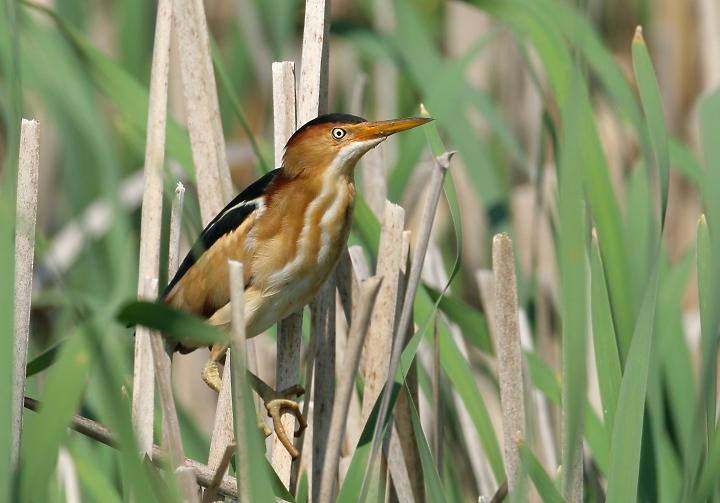
Ixobrychus exilis
SUBFAMILY
Botaurinae
TAXONOMY
Ardea exilis Gmelin, 1789, Jamaica. Five subspecies.
OTHER COMMON NAMES
English: Nitlin, gaulin; French: Petit blongios; German:
Amerikanische Zwergdommel; Spanish: Avetorillo Panamericano.
PHYSICAL CHARACTERISTICS
The least bittern is the smallest heron (11–14 in [28–36 cm]), a
pale buff bird with a dark crown and back and buff-colored
wing patches. The female averages larger than the male. It has
chestnut, rather than black, upperparts, a less prominent
crown, darker neck stripes, dark brown chest streaks, and paler
wing patch. Juveniles are similar to females.
DISTRIBUTION
The least bittern occurs in North America, Central America,
West Indies, and north, west and east South America.
HABITAT
The habitats typically are very dense marsh vegetation in water
with both woody growth and open water patches. These include
fresh water marshes, lake edges, salt marshes in temperate
areas, and mangroves in the tropics.
BEHAVIOR
The least bittern feeds by stalking through the reeds or along
the edge of dense reed stands or on branches over the water. It
walks in very crouched posture, with its neck extended and its
bill nearly touching the water. It may also feed by standing in
one place and may build feeding platforms. The bittern posture
is often assumed as a defensive display. The least bittern is
very vocal, giving a low pitched, dove like advertising call and a
rattling disturbance call.
FEEDING ECOLOGY AND DIET
It feeds within dense emergent vegetation. The principal prey
is small fish, but its overall diet is much broader including
crabs, crayfish, insects, frogs, tadpoles, salamanders, small
mammals, and even small birds.
REPRODUCTIVE BIOLOGY
In the north, it nests in the spring and summer and at more
varied times in the tropics. Nests are placed in thick herbaceous
marshes, most commonly in cattail. It nests solitarily or
in small groups. The male constructs the nests and advertises
with a distinctive cooing call and defends its territory. The
eggs are white. Clutch size is four or five eggs, with fewer in
the tropics. Unlike in the large bitterns, both sexes incubate
and care for young. Chicks develop quickly, being able to leave
the nest temporarily by day five, wandering by two weeks.
They fledge in about three or four weeks.
CONSERVATION STATUS
Not threatened. Conservation of this species depends on marsh
preservation. Water impoundments and wetland construction for
various purposes increase the potential habitat for the species as
it often nests in cattail marshes created by human activities.
SIGNIFICANCE TO HUMANS
None known. Least bitterns are seldom noticed, due to their
small size and secretive ways. They are charming small birds
that well deserve additional attention.
Photo Gallery of - Least bittern




 Animalia Life
Animalia Life